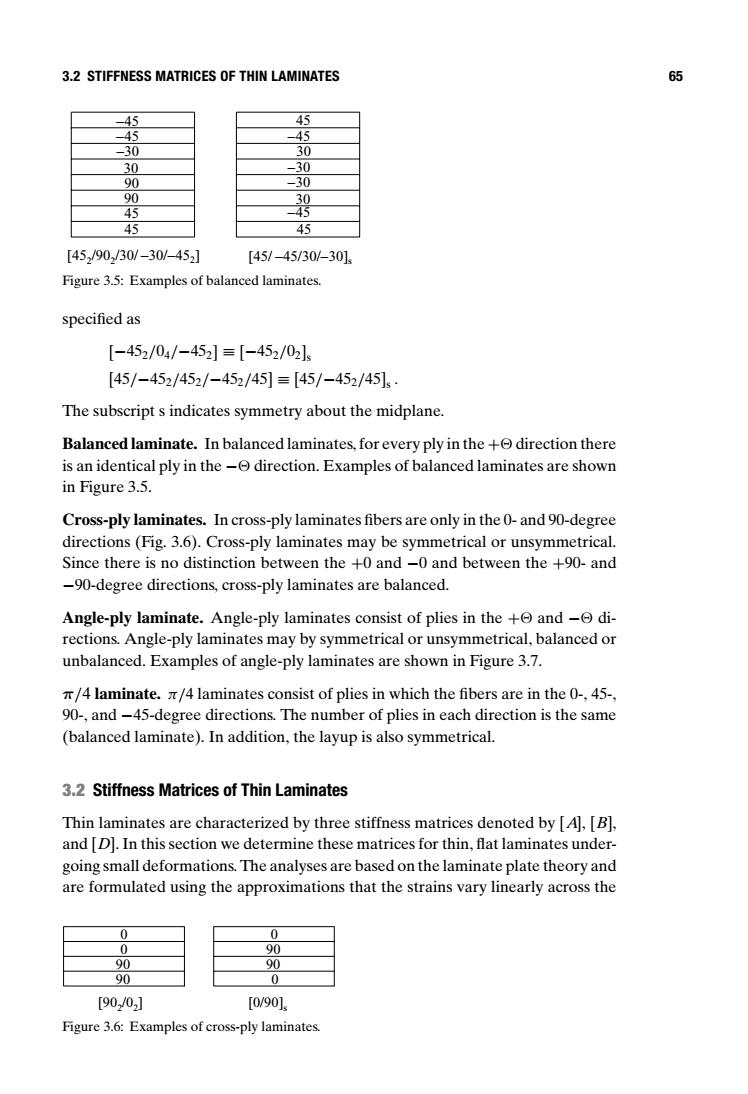正在加载图片...

3.2 STIFFNESS MATRICES OF THIN LAMINATES 65 -45 45 -45 -45 -30 30 30 -30 90 -30 90 30 45 -45 45 45 [45,/90/301-30/-452] [45/-45/30/-301s Figure 3.5:Examples of balanced laminates. specified as [-452/04/-452]=[-452/02ls [45/-452/452/-452/45]=[45/-452/45]s The subscript s indicates symmetry about the midplane. Balanced laminate.In balanced laminates,for every ply in the+direction there is an identical ply in the-direction.Examples of balanced laminates are shown in Figure 3.5. Cross-ply laminates.In cross-ply laminates fibers are only in the 0-and 90-degree directions(Fig.3.6).Cross-ply laminates may be symmetrical or unsymmetrical. Since there is no distinction between the +0 and-0 and between the +90-and -90-degree directions,cross-ply laminates are balanced. Angle-ply laminate.Angle-ply laminates consist of plies in the and-6 di- rections.Angle-ply laminates may by symmetrical or unsymmetrical,balanced or unbalanced.Examples of angle-ply laminates are shown in Figure 3.7. /4 laminate./4 laminates consist of plies in which the fibers are in the 0-,45-, 90-,and-45-degree directions.The number of plies in each direction is the same (balanced laminate).In addition,the layup is also symmetrical. 3.2 Stiffness Matrices of Thin Laminates Thin laminates are characterized by three stiffness matrices denoted by [A],[B], and [D].In this section we determine these matrices for thin,flat laminates under- going small deformations.The analyses are based on the laminate plate theory and are formulated using the approximations that the strains vary linearly across the 0 0 90 90 90 90 0 [902/0] [0/901g Figure 3.6:Examples of cross-ply laminates.3.2 STIFFNESS MATRICES OF THIN LAMINATES 65 30 90 90 –30 –30 –30 [45 /90 2 2/30/ –30/–452] 45 45 30 45 30 45 [45/ –45/30/–30]s –45 –45 –45 –45 Figure 3.5: Examples of balanced laminates. specified as [−452/04/−452] ≡ [−452/02]s [45/−452/452/−452/45] ≡ [45/−452/45]s . The subscript s indicates symmetry about the midplane. Balanced laminate. In balanced laminates, for every ply in the + direction there is an identical ply in the − direction. Examples of balanced laminates are shown in Figure 3.5. Cross-ply laminates. In cross-ply laminates fibers are only in the 0- and 90-degree directions (Fig. 3.6). Cross-ply laminates may be symmetrical or unsymmetrical. Since there is no distinction between the +0 and −0 and between the +90- and −90-degree directions, cross-ply laminates are balanced. Angle-ply laminate. Angle-ply laminates consist of plies in the + and − directions. Angle-ply laminates may by symmetrical or unsymmetrical, balanced or unbalanced. Examples of angle-ply laminates are shown in Figure 3.7. π/4 laminate. π/4 laminates consist of plies in which the fibers are in the 0-, 45-, 90-, and −45-degree directions. The number of plies in each direction is the same (balanced laminate). In addition, the layup is also symmetrical. 3.2 Stiffness Matrices of Thin Laminates Thin laminates are characterized by three stiffness matrices denoted by [A], [B], and [D]. In this section we determine these matrices for thin, flat laminates undergoing small deformations. The analyses are based on the laminate plate theory and are formulated using the approximations that the strains vary linearly across the 0 [90 /02 2] 90 0 90 0 [0/90]s 90 90 0 Figure 3.6: Examples of cross-ply laminates